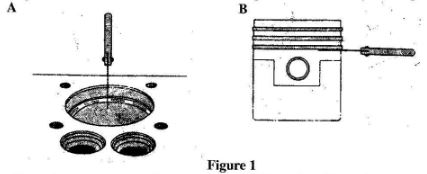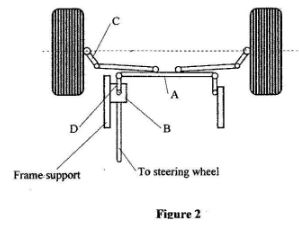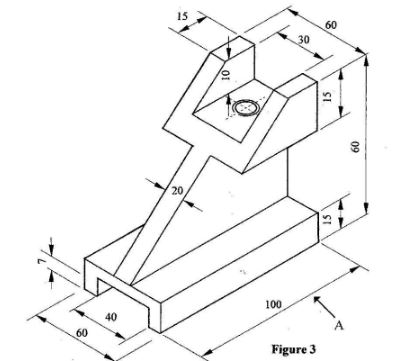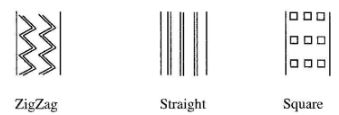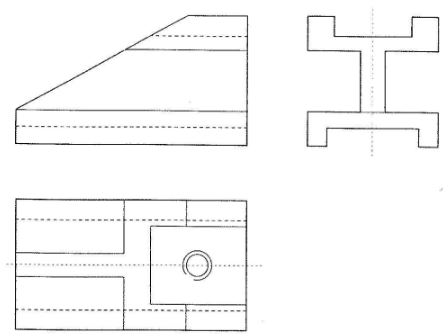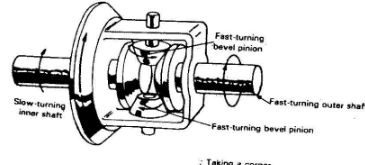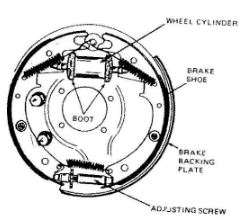POWER MECHANICS (447)
SECTION A (40 marks)
Answer all the questions in this section.
-
- Name two areas in a power mechanics workshop which require ventilation.(1 mark)
- Name two automotive trade courses offered at the Directorate of Industrial Training.(1 mark)
-
- Sketch a countersunk rivet and label two main parts.(2 marks)
- Use sketches to differentiate between Acme and butress type of screw thread.(2 marks)
-
- State the two major classifications of greases.(1 mark)
-
- State the meaning of the term volatile as applied to materials.
- Give two examples of volatile materials.(2 marks)
-
- State the meaning of each of the following engine terminologies:
- bore;
- throw;
- volumetric efficiency.
(3 marks)
- State two functions of the charging system in an engine.(2 marks)
- State the meaning of each of the following engine terminologies:
-
- Name three checks that must be carried out when fitting new piston rings on a dismantled single cylinder engine piston.(3 marks)
- Figure 1 shows two measurements A and B performed as an engine component.
Name the measurement, the component and the tool used in each case.(3 marks)
-
- State the function of each of the following components in a vehicle electrical circuit:
- diode;
- relay.
(2 marks)
- State four possible causes of engine backfiring.(2 marks)
- State the function of each of the following components in a vehicle electrical circuit:
-
- Sketch and name two types of tyre tread patterns.(2 marks)
- List four different components that are involved in absorbing shock when a vehicle hits a bump.(2 marks)
-
- State the meaning of each of the following as used in hydraulic braking system:
- Bleeding;
- Flushing.
(2 marks)
- Figure 2 shows a simplified drawing of a steering system.
Name the parts labelled A to D.(2 marks)
- State the meaning of each of the following as used in hydraulic braking system:
-
- Name two types of vehicle rear axles.(1 mark)
- Differentiate between dead and live axles. (2 marks)
-
- State how the size of each of the following tools is determined:
- open end spanner;
- ball pein hammer.(2 marks)
- Make a freehand drawing of straight snips and label two main parts.(3 marks)
- State how the size of each of the following tools is determined:
SECTION B (60 marks)
Answer question ll and any other three questions from this section. Candidates are advised to spend not more than 25 minutes on question 11.
- Figure 3 shows an isometric drawing of an engine mounting, Draw, full size in first angle projection the following views:
- Front elevation in the direction of arrow A;
- End elevation;
- Plan.(15 marks)
-
- Name four types of fuel used in motor vehicle engines.(2 marks)
- Figure 4 shows the layout of a compression ignition engine fuel system
- Name the parts labelled U, V, W, X, Y and Z.(3 marks)
- Explain how the system operates.(10 marks)
-
- Explain the use of the following units in a propeller shaft:
- universal joint;
- slip joint.(2 marks)
- With the aid of a labelled diagram, explain the operation of a differential unit when a vehicle is taking a turn.(13 marks)
- Explain the use of the following units in a propeller shaft:
-
- State three advantages of disc brakes over drum brakes.(3 marks)
- With the aid of a labelled diagram, describe the construction of the drum brakes assembly.(12 marks)
-
- Illustrate the following frame sections used in a motor vehicle:
- channel;
- box;
- tubular.(3 marks)
- Describe four types of car bodies.(6 marks)
- Explain the three methods of checking minor chassis frame misalignment.(6 marks)
- Illustrate the following frame sections used in a motor vehicle:
MARKING SCHEME
-
-
- Workshop areas
- Charging area
- Spraying/painting
- Soldering/Welding
- Storage for volatile materials
Any 2 x 1/2
- Trade courses at DIT
- General mechanics
- Panel beating
- Auto-electrics
- Spraying
- Uphostery and interior decoration
Any 2 x 1/2
-
-
- Countersink Rivet
- Screw Thread
Sketch 1
Labelling 2 x 1
(2 x 1)
- Countersink Rivet
-
- Greases
- Soap base
- Number base
(2 x 1/2 marks)
- Volatile: Substances which readily turn to vapour at a relatively low temperature.
(1 x 1) e.g. petrol, cellulose, thinners, paint, spirits.
Any 2 x 1/2
- Greases
-
- Terminology
- Bore: Is the diameter of an engine cylinder.
- Throw: Is the distance between centreline of the crankshaft and the centreline of a crankpin. V
- .E: Is the amount of air drawn in a cylinder divided by the actual volume of the cylinder.
(3 x 1 marks)
- Charging System
- Restores back into the battery the current used to start an engine.
- Handles the load of lights, ignition, radio and other circuits when engine is running(2 x 1)
- Terminology
-
-
- Checks on Connecting Rod
- Rod side clearance
- Big end for wear
- Rod alignment for out of round
- Bushings for wear and scoring
- Measurements
A: Ring gap, piston ring, feeler gauge
B: Side clearance, piston ring, feeler gauge
(1 1/2 x 2)
-
-
- Electrical component
- DIODE converts AC produced by alternator to DC
- RELAY is a magnetic switch used in various electrical circuits.
2x1
- Engine Backfiring
Wrong ignition timing
Wrong S.P. range
Too lean mixture
Too rich mixture
Carbon deposits
Overheating
Faulting condenser
Any 4 x 1/2
- Electrical component
-
- Types of Thread Patterns
-
- Absorbing shocks
- Car tires
- Shock absorbers
- Spring in vehicle seats
- Suspension springs
(4 x 1/2)
- Types of Thread Patterns
-
-
- Meaning
- Bleeding is the process of removing trapped air in braking system
- Flushing is the process of removing old/used fluid from the system.
(2 x 1)
- Steering system
- Track rod
- Steering gear box
- Steering arm
- Idler arm
(4 x 4 1/2)
-
-
-
- Rear Axles
- Semi-floating
- Three quarter floating
- Full floating
-
- Live axle transmits
- While dead axle doesn't transmit
-
-
- Tool sizes
- Spanner is the distance between the two jaws
- Hammer is the weight of the head
(2 x 1)
- Straight snips(3 marks)
- Tool sizes
-
-
-
- Petrol
- Diesel
- Gasohol
- Liquidified petroleum gas(4 x 1/2 = 2)
-
-
- Fuel tank - U
- Course filter - V
- Lift pump - W
- Fine filter (s) - X
- Injector pump - Y
- Injectors - Z
(6 x 1/2 = 3)
- Operation
- As the engine crankshaft rotate, a low pressure (depression) is created in the chamber of the lift pump. This creates a pressure difference between the pump chamber and the tank, thereby causing fuel to be drawn into the lift via the course filter. The course filter removes large dirt particles from the fuel.
- As the crankesraft continues to rotate, the lift pump then applies a higher pressure to the fuel and forces it through the fine filters to the galleries of the injector pump. The fine filters remove any remaining fine particles from the fuel because diesel requires to be extremely clean.
- The injector pump accurately meters the right amount of fuel to each injector nozzle and also pumps it at very high pressure at the end of each compression stroke, and in accordance with the firing order.
- Each injector atomises the fuel and sprays it to the compressed air in each cylinder, thereby causing combustion to take place.
- Due to the very pressures in the system, some fuel always escapes back past the injector nozzles. This is collected by the leak-off pipes and is returned either to the tank to the intake side of the fine filter.
(10 marks)
-
-
-
-
- Universal Joint compensates for change in drive shaft angle.
- Slip joint compensates for change in drive shaft length.
(2 x 1 marks)
- Operation of Differential unit when cornering.
Sketching = 4
Labelling = 3- Cornering
- When taking corners, the resistance on the rotation of the inner axle bevel gear increases as the wheels turn at different speeds. This causes the differential pinion gears to turn on their own axis and roll around the axle bevel gears. When this happens the inner wheel axle gear slows down. This causes the pinion gear to 'walk around the slower turning axle bevel gear.
- This results in additional rotary motion being transmitted to the outer axle bevel gear causing the axle shaft to turn faster but still providing equal power to both wheels. In some cases one of the driving wheels can have little or no traction, the torque required to turn the wheel without traction being very low. The wheel with good traction is in effect holding the axle bevel gear on that side stationery. Consequently, the differential pinion gears 'walk around the stationary side axle bevel gear and drive the other wheel at twice the speed. This, the wheel with no traction will be essentially slipping. A wheel with no traction cannot deliver torque, hence, all the turning effort goes to the slipping wheel. To counter wheel slippage, non-slip differential or differential locks are used.
(6 x 1 marks)
- Cornering
-
-
-
- Advantages of disc brakes
- Greater heat dissipation
- Cleaner braking surfaces
- Lighter in weight
- Simpler construction hence easier to service
Any 3 x 1
- Construction of drum brake assembly
Sketching and labelling(4 marks)
The assembly comprises the following:- Brake Drum made of iron and bolted to the wheel to rotate together.(2 marks)
- Backing plate made of steel and covers the show assembly.(2 marks)
- Shoe assembly comprising two shoes, wheel cylinder, springs, adjusting screwsand anchor plate.(2 marks)
- Wheel cylinder fitted between the ends of the shoes to activate them when brakes are applied. (2 marks)
- Springs, linkages and fasteners.
Total marks for explanation = 8
-
-
- Frame Sections
- Types of Car Bodies
- Saloon (sedan) has closed body with four doors.
- Station wagon (estate) has extended roof to the rear and folding rear seat to create space for luggage.
- Coupe (sport) has closed body with two doors and lowered roof towards the back.
- Convertable (drop head) closed car that can be opened by removing or lowering the roof.
Naming 4 x 1/2
Description 4 x 1
- Checking minor misalignment
- Wheel base check
- Set front wheels in the straight position
- Check wheel base on each side
(2 marks)
- Alignment
- Check to ensure rear wheels are parallel to each other
- Hold straight edge against the rear wheel
- Turn the front wheel until parallel to straight edge
- Do the same for both sides
- Plumbline check
- Drop plumbline from both sides of each shackle of the spring and mark on the floor with chalk for all the 8 points.
- Join the chalk marks diagonally
- If frame is aligned, all the diagonals should across at the centre line.
Naming 3 x 1
Description 3 x 1
- Wheel base check
- Frame Sections
Download KCSE 2011 Power Mechanics Paper 1 Questions with Marking Scheme.
Tap Here to Download for 50/-
Get on WhatsApp for 50/-
Why download?
- ✔ To read offline at any time.
- ✔ To Print at your convenience
- ✔ Share Easily with Friends / Students

